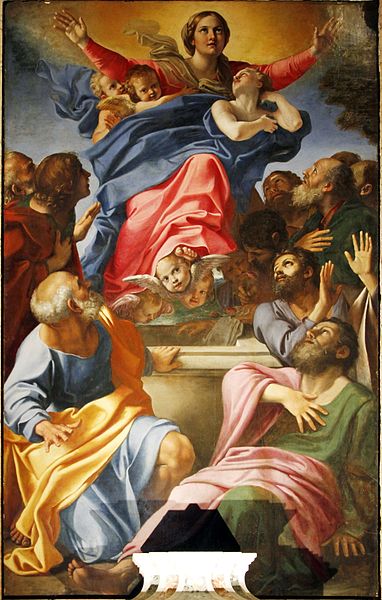
Title: Assumption of the Virgin
Artist: Annibale Carracci
Date Painted: c. 1600-1601
Medium: Oil on Wood
Dimensions: 245cm x 155cm
Period: Baroque
Location: Cersai Chapel, Santa Maria del Popolo, Rome
Summary of the Assumption of the Virgin
The Assumption of the Virgin by Annibale Carracci is a significant masterpiece that embodies the essence of the Baroque art movement, notable for its dramatic use of color, light, and dynamic composition to evoke deep emotional and spiritual responses. This work, painted between 1587 and 1589, is located in the Cerasi Chapel of Santa Maria del Popolo in Rome, highlighting Carracci’s pivotal role in the development of Baroque painting in Italy.
The painting depicts the biblical and apocryphal event of the Virgin Mary’s assumption into heaven. In this scene, Mary is surrounded by a host of angels as she ascends, her arms open and her gaze lifted upwards towards the divine light that illuminates her from above. This celestial moment is charged with spiritual fervor, showcasing Carracci’s ability to merge the physical and spiritual realms in a harmonious composition.
Carracci’s technique is characterized by his use of chiaroscuro (the contrast between light and dark) to model the figures, giving them a three-dimensional form that seems to project out of the painting. The colors are rich and vibrant, with the deep blues and reds of Mary’s robes creating a striking contrast against the golden light that bathes her and the clouds around her. The composition is dynamic yet balanced, with the figures of the apostles below, who witness the scene in a variety of emotional states, providing a grounding counterpoint to the heavenly ascent.
The emotional expressiveness of the figures is a hallmark of Carracci’s work and of Baroque art in general. Each apostle’s face reflects a different aspect of human reaction to the divine mystery, from awe to devotion, capturing the moment’s profound spiritual significance. This ability to convey complex emotional states through art was revolutionary at the time and contributed significantly to the development of Baroque painting.
The Assumption of the Virgin by Annibale Carracci is not just a religious painting; it is a visual sermon, a deeply felt representation of faith that seeks to engage the viewer’s emotions and draw them into a contemplative engagement with the divine. Through his masterful use of color, light, and composition, Carracci created a work that transcends its time, offering viewers across ages a glimpse into the sublime.